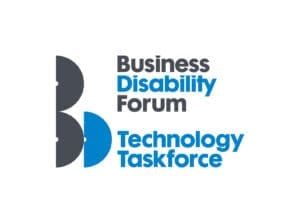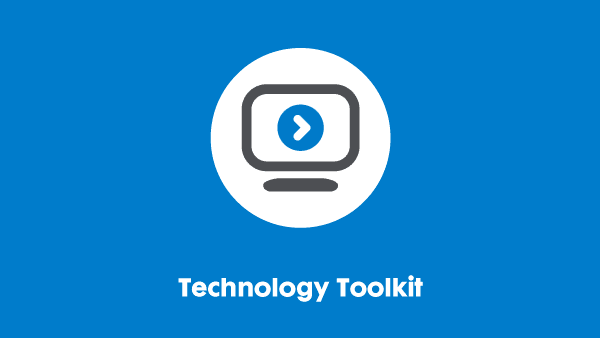Last updated: 4 August 2025
Raising digital accessibility awareness across an organisation
This resource was created by our Technology Taskforce, a group of senior IT accessibility individuals from leading UK and global organisations. For more information, including how to join, see our website.

Introduction
In this page, we (the Technology Taskforce) offer our reasoning and high-level advice as to what this means and what we think you should do to help you achieve this goal. We have laid this document out in the order we feel will help you dip your toe into the subject if you are new to it and immerse yourself more as you read on.
There is further information and guides on the Technology section of our website for those that want to find more detailed guides.
What is digital accessibility?
Digital accessibility is the ability of a website, mobile application or electronic document to be easily navigated and understood by everyone. This includes those who have visual, auditory, motor, cognitive, or any other kind of disabilities.
Why is digital accessibility important?
Modern consumers rely on online sources of information to find out what they need to know about businesses with which they interact. Our 2021 consumer research found that websites are – by a wide margin – the first place disabled consumers go to for information about an organisation. Yet, over half of respondents (54 per cent) said that their purchasing options were limited by how information is presented.
Many users use Assistive Technology (AT) to help them lessen the impact of their disability – but poor design can make the AT less effective than they could be, making it more difficult for the user to interact with the digital content.
This hurts disabled consumers and businesses.
BDF estimated in March 2016 that £1.8 billion per month was being lost to businesses as disabled customers, and their families and friends, walked away from service providers that were not disability smart. The Click-Away Pound survey is a research survey designed to explore the online shopping experience of people with disabilities and examine the cost to business of ignoring disabled shoppers. The 2019 survey report showed:
- 69 per cent of disabled customers with access needs will click away from a website that they find difficult to use.
- Those customers who click away have an estimated spending power of £17.1 billion in the UK alone, around 10 per cent of the total UK online spend.
- 82 per cent of customers with access needs would spend more if websites were more accessible.
How is digital accessibility achieved across a business?
To ensure that your information is accessible to all, you need everyone in your business to do their part. Raising awareness among all your employees helps to ensure that the right people are doing the right thing in the right way. Below we recommend ways to help get this message across.
Executive level sponsor
Having your board understand and promote the need for digital accessibility is essential to help push messages with authority around the business. Partner and/or director involvement in promoting the cause can speed up transformation in this arena and also helps to advertise to the outside world that your business is open for business to all.
The sponsor understands why the business needs accessibility, identifies benefits and risks. The sponsor is the person at board level that communicates that we should do this, and the benefits to our organisation and what accessibility means for us.
The sponsor is the person who creates the momentum for accessibility – expressing why it can’t be delayed. They will be a source of funding and support, acting in the role of facilitator and escalation point for tricky accessibility issues.
The sponsor engages key stakeholders
The sponsor acts as chair of the organisation’s accessibility taskforce / steering group (drawn from key stakeholders). They will need to manage executive peers as well as downwards and represent your organisation’s accessibility goals externally. They will also report back to the board on activities and align them with organisational strategy and priorities.
Read our resource, ‘Accessibility Champions and Sponsors’ for more information.
Accessibility/disability champions
An accessibility/disability champion can inspire those around them and help to spread knowledge of the topic. They can help to clarify the business case and get management buy-in. They can also act as local guides, directing the rest of the staff to the correct place to find the information they need.
Some groups of staff can sometimes be negative (especially if they have had bad experiences) and some can be overwhelmingly positive. Guidance to them from the champions can be very useful to either lift the mood or explain why a particular path has to be taken.
Depending on the size of the organisation and the type of employees, the champion role may have different levels of knowledge associated with it.
Technical champion
In an IT team, the technical champion is the person most qualified in relation to correctly coding buttons, lists, etc. according to the W3C guidelines. They would be able to explain to the programming teams why things have to be done in a particular way.
The technical champion might be up to date with the latest versions of guidance and best practice. They might also be aware of forums related to AT applications and issues related to different versions of AT to help the programmers and testers.
Non-technical champion
The non-technical champion is a person that is passionate about the topic of accessibility and aware of the type of issues that people with disabilities have when using IT. They can demonstrate or publicise those issues to ensure that the technical teams understand the challenges faced by disabled users and build the case for change.
The non-technical champion should be able to clearly communicate issues faced by users when a product is not designed and built with accessibility in mind. It would be down to the technical teams to make the changes necessary.
Champions’ feedback
Champions can also be used to help make HR and Wellbeing teams aware of options available to disabled staff by keeping abreast of the type of AT that their people use. They can also act as a good conduit for feedback on what works and what doesn’t work with their disabled colleagues.
Building and keeping a good rapport with disabled staff helps the champion build trust and, in turn, receive more honest feedback on where the technical teams and/or HR and Wellbeing teams may need to concentrate their efforts.
Read our resource, ‘Accessibility Champions and Sponsors’ for more information.
Support networks
One way to improve the accessibility experience of your users is to set up a user support network, within which they support each other. The benefits of setting up a user support network include:
- It uses the skills and experience they have developed, which makes them feel valued
- It helps other people increase their job satisfaction
- It costs a lot less than bringing in outside experts to do your training and support.
Some external trainers will probably still be necessary except in the largest organisations.
Some people with accessibility requirements are technophiles who love to play with their IT, learning the quirks of applications and finding new and better ways to use them. Most are very happy to share their knowledge with others. Similarly inclined colleagues will bounce off each other’s discoveries and go on to further develop their expertise, but vitally, from the organisation’s point of view, they will also share their knowledge with colleagues who are having trouble with the applications. They can provide mentoring, instruction, or step-by-step guidance that users can follow to improve their use of the application, and therefore their efficiency at work.
To encourage this, you could set up an internal communication channel. The ideal is internal social media, either discussion groups or forums. In a large organisation, groups can specialise in a particular assistive software package. In a smaller one, they may need to get together to get the critical number of users to keep the group active, so all the AT packages might be discussed in one forum.
Where possible, the media should have persistent postings. An email group is acceptable if you have nothing better, but ideally users should be able to go into past threads to find something that was discussed months or even years ago, but they now need to know about or to revise and update advice in the light of new discoveries or system changes.
“Our staff is our greatest asset” is something you hear many times. That they can help improve each other’s efficiency through support networks is one of the reasons that is true.
Technical expertise (identify, promote)
Identifying individuals within the organisation with expertise in technical matters relating to digital accessibility can help to raise awareness.
Specifically, identifying subject matter experts who are willing to engage with and mentor their colleagues will lead to faster and more consistent uptake of accessibility standards. They will also help remove blockages and streamline access to resources and other subject matter experts, champions and executive level sponsors.
Technical standards
It is important to set clear expectations on technical standards and to implement a governance process when producing accessible content within an organisation.
The governance process will ensure that accessibility is considered when producing any content. It will also ensure content producers are aware of the standards and available training.
Training (technical, end user)
To ensure employees within an organisation understand the importance of considering consumers with accessibility needs, we recommend a digital accessibility awareness programme. This should provide all employees with the knowledge and tools they need to create accessible documents.
The training should be aimed at a broad base of recipients. It should set out context, organisational expectations and best practice and may incorporate online training courses or instructor lead training. See our resource ‘Accessibility training: A guide to available resources’ for more information.
In addition to end user training delivered broadly to the organisation, personnel developing digital content will benefit from additional technical training.
Governance and testing
At its simplest, governance is the process of overseeing accessibility within the organisation and tracking progress.
Not every organisation has the luxury of a dedicated accessibility function, but it is possible to have a steering committee or similar structure that takes responsibility for governance of accessibility that meets on a regular basis.
High level governance activities include:
- Engagement with the accessibility sponsor (activities likely to be led by champion)
- Agreeing which standards the organisation wishes to adopt, how they will be measured and enforced
- Agreeing strategic direction for accessibility and set organisational targets in agreement with the accessibility sponsor
- Key performance indicators for measuring accessibility and the provision of reasonable adjustments. A example of this would be to use the Accessibility Maturity Model and to sign up to the Accessible Technology Charter
- Act as escalation point for accessibility issues reporting and resolution.
Low-level governance activities include:
- Accessibility testing and audits
- Engagement with partners and suppliers.
Our resource on accessibility testing has more information.
If you require this content in a different format, contact enquiries@businessdisabilityforum.org.uk.
© This resource and the information contained therein are subject to copyright and remain the property of the Business Disability Forum. They are for reference only and must not be copied or distributed without prior permission.
